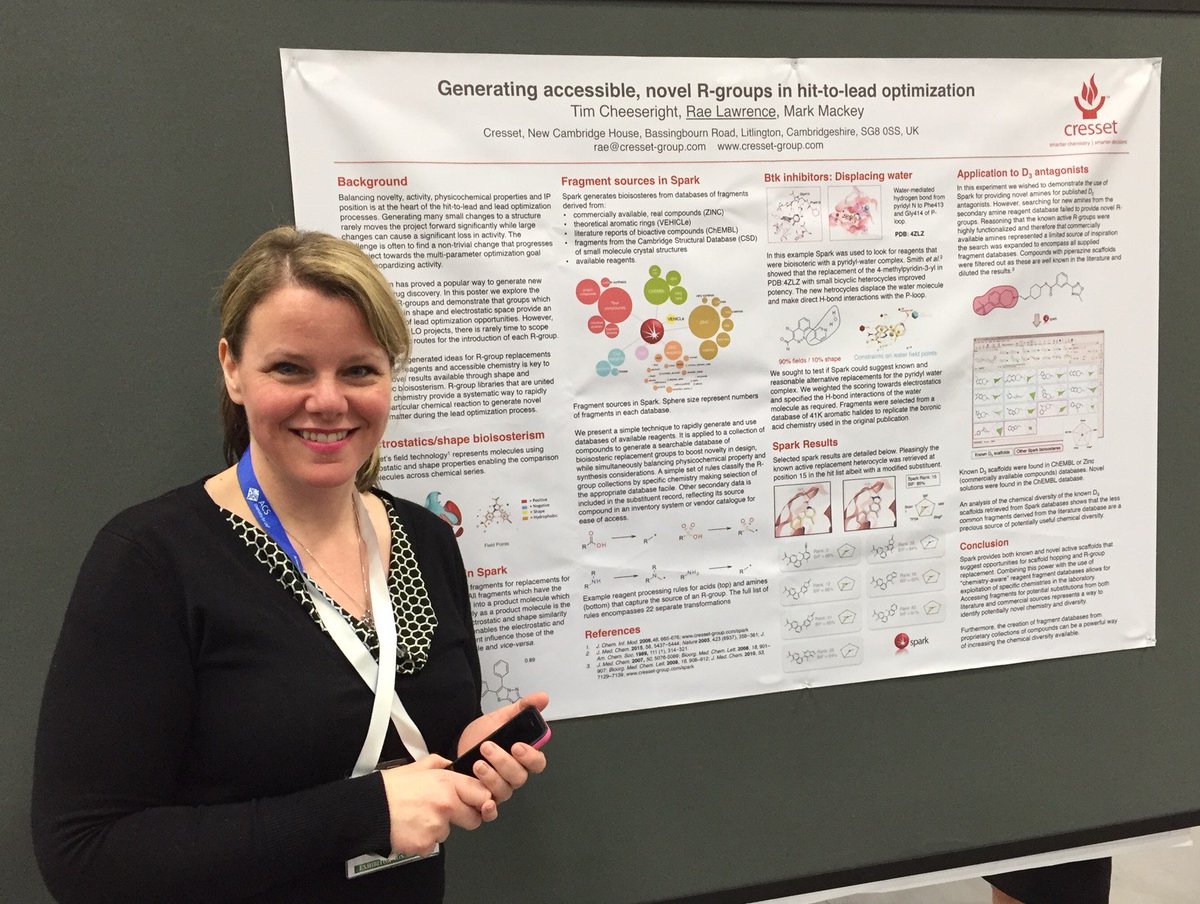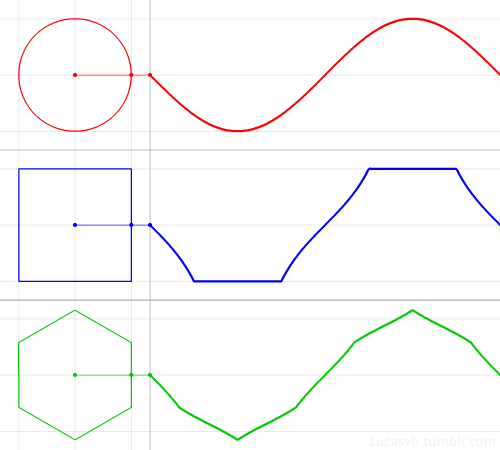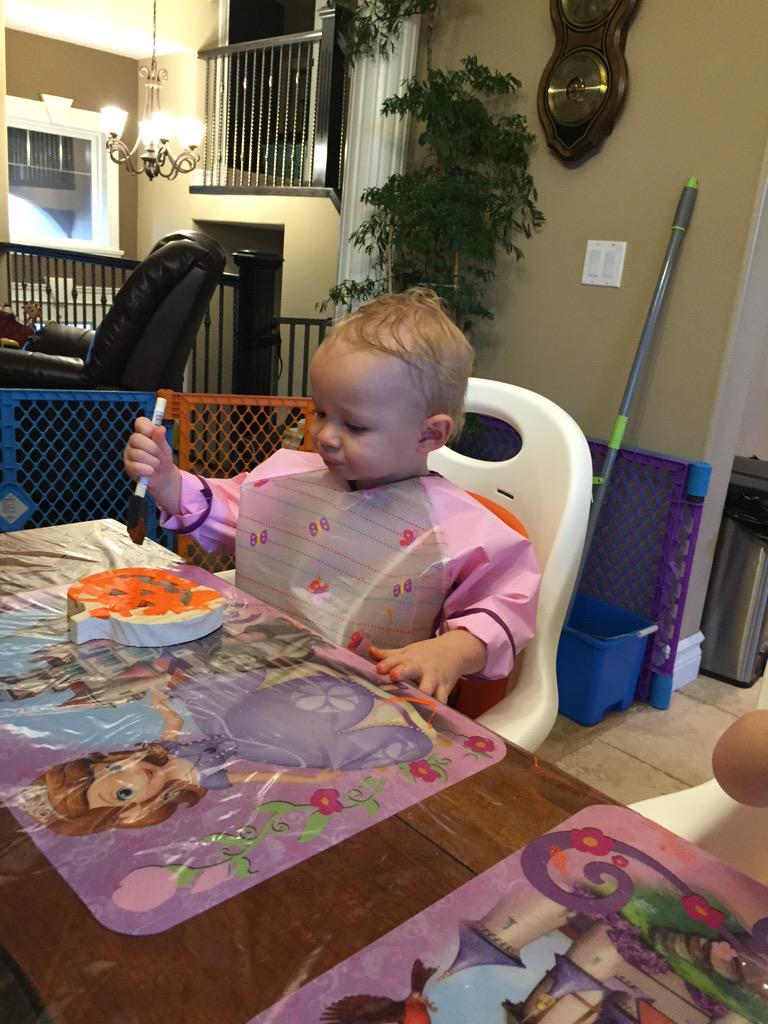.
Dr. Rae Lawrence
Life Sciences Software
Technical Sales Manager at Cresset
PhD Theoretical
Chemist doing comp-aided drug design in SE Alberta.
Supermom of twins -
raising them to be Liberal, global citizens.
Lives Desert Blume, AB

Dr. Rae Lawrence has the monumental task of mananging a sales territory that includes the whole of North America. She has a PhD in Computational Chemistry, over 10 years of experience in the chemistry software industry, and for the past year has been more than up to the challenge of single-handedly spreading the Cresset word in Canada and the United States.
Summary
Rae
has been working in the life sciences software industry since 2000, and
has provided software application and sales support spanning large
pharma, biotech, speciality chemical, NPO, government and academia.
Specialities include:
Computational Chemistry, Cheminformatics, Bioinformatics, Quantum chemistry. Life Sciences, Molecular Modeling, Ligand-Based Drug Design, Computer-Aided Drug Design, Lead Discovery, Library Design, Scientific Consulting Services, Scaffold-Hopping and Lead Optimization, Small Molecule Drug Discovery, Field-Based Chemistry.

Cresset @cressetgroup
Specialities include:
Computational Chemistry, Cheminformatics, Bioinformatics, Quantum chemistry. Life Sciences, Molecular Modeling, Ligand-Based Drug Design, Computer-Aided Drug Design, Lead Discovery, Library Design, Scientific Consulting Services, Scaffold-Hopping and Lead Optimization, Small Molecule Drug Discovery, Field-Based Chemistry.

Cresset
Miss our posters & orals at #ACSsandiego? Subscribe to receive copies http://bit.ly/MwtlYd @ACSNatlMtg #CompChem

Can you keep all the SAR in your head?
This work presents a technique for locating Activity Cliffs in the context of the target active site. Using this method critical SAR regions are clearly and rapidly identified. Furthermore the reason for the activity differences between pairs of compounds is readily discernable, leading to a true understanding of the SAR landscape.
http://

LINKS
https://ca.linkedin.com/in/rae-lawrence-life-sciences-software-3164b54
http://www.cresset-group.com/2011/10/8-questions-with-rae-lawrence/
http://www.cresset-group.com/tag/web-clip/#
http://www.cresset-group.com/
http://www.cresset-group.com/contract-research/
@raelawrence1
Work - rae@cresset-group.com
Home - rae_lawrence@hotmail.com
Cresset
New Cambridge House, Bassingbourn Road, Litlington, Cambridgeshire, SG8 0SS, UK
tel: +44 (0)1223 858890 mobile: +1 (403) 594 2670 fax:
+44 (0)1223 853667
Experience
Technical Sales Manager
Cresset
Cresset
Group is in the business of helping organizations in the biotech-pharma
industry by providing software technology to provide a unique insight
into the biological activity, properties and interactions of molecules,
which in turn, allows researchers to quickly and easily compare
structures and determine whether structurally diverse compounds might
share common activity/biological properties.
Cresset’s software is based on 3D electrostatic fields. The technology provides insight into the way ligands are seen by receptors, and is used in a number of ways by our products to:
• Interrelate compounds from differing chemical series that act on the same target;
• Find novel chemical series through virtual screening;
• Decode SARS by comparing molecules as proteins “see” them;
• Provide an accurate basis to identify novel, chemically relevant bioisosteres.
Cresset’s software is based on 3D electrostatic fields. The technology provides insight into the way ligands are seen by receptors, and is used in a number of ways by our products to:
• Interrelate compounds from differing chemical series that act on the same target;
• Find novel chemical series through virtual screening;
• Decode SARS by comparing molecules as proteins “see” them;
• Provide an accurate basis to identify novel, chemically relevant bioisosteres.
Consultant
RL Scientific Consulting
Providing computational chemistry expertise.
* Experimental & Results review
* Computational Program evaluation & design
Specializing in:
*Bioinformatics
*Cheminformatics
*Computer-Assisted Drug Design
*Ab Initio and DFT
* Coordination compounds
* Weakly bound clusters
* Experimental & Results review
* Computational Program evaluation & design
Specializing in:
*Bioinformatics
*Cheminformatics
*Computer-Assisted Drug Design
*Ab Initio and DFT
* Coordination compounds
* Weakly bound clusters
President / General Manager
Cypress Heating & Refrigeration Ltd.
Cypress
Heating & Refrigeration Ltd provides commercial and residential
heating, air-conditioning and refrigeration installations, repairs,
replacements and service for Medicine Hat and surrounding areas.
Education
University of Missouri-Columbia
PhD, Theoretical Chemistry
DFT studies of Rhodium tetrathioether complexes; HCN-H3N clusters, Water clusters, and more.
Activities and Societies: Chemistry Grad Student Association, CASA, Magic of Chemistry, Newton Academy
Advice for Contacting Rae
Work - rae@cresset-group.com
Home - rae_lawrence@hotmail.com
Home - rae_lawrence@hotmail.com
Contact
New Cambridge House, Bassingbourn Road, Litlington, Cambridgeshire, SG8 0SS, United Kingdom
Tel: +44 (0)1223 858890 Fax: +44 (0)1223 853667
Anthony Melvin Crasto WITH DR RAE LAWRENCE, CRESSET........... Cambridge, UK, At an International lecture on 'Using Molecular personalities for smarter Medchem design and SAR analysis, A Cresset approach', At IY college, chem dept, Jogeshwari east, Mumbai, India......On 25 Nov 2015 — with ANTHONY MELVIN CRASTO at Ismail Yusuf College.
Tags: Drug discovery, Computational chemistry and Cresset




Food at International lecture was home made maharashtrian style served to visitors, Methi chi bhaji, vangi bharlele, bhakri, puria, kombdi kalvan, bhath, etc
PICS


We don’t know how she manages to do it all, but we’re very glad that she does. Get to know the funny, intelligent and extremely hard working Rae, as we present 8 Questions with Rae Lawrence:
1. What was your first job?
I was in the performing arts. I was part of a local theater troupe as a quadruple threat – act/sing/dance and several musical instruments (as needed). I did this for a couple of summers before I got my first lab job.
2. Which projects are you most proud of?
I’ve been involved behind the scenes in a number of projects – protein homology modeling, GCPR modeling, active site characterization, and model building – and I’m pleased with each of the projects where I’ve had the opportunity to provide input. My biggest “pride-project” would have to be finishing the basement in our last home minus the plastering and carpet. I’ve gotten pretty good at installing tile, electrical and baseboards – and even have my own Brad Nailer!
3. Who has been your biggest influence professionally?
I’m going to suck up and say “Andy Vinter”
4. What do you think about the future of Drug Discovery technology?
I really don’t know.
I’m seeing a lot of companies put all of their eggs in one basket and focusing on one or two clinical trials, at the expense of discovery departments. If, and more likely “when” the trials fail, what happens then? Is there anything in the discovery pipeline? Nope – because discovery was canned. I hope companies can strive for a better pipeline balance.
The past ten years ago have had boom and bust cycles in research spending, and despite assurances that the economy is getting better, our industry is still seeing massive cuts in people-power and funding. It’s completely depressing. I know many excellent drug discovery scientists who after being jobless, have retrained for other careers like real estate, radiology, accounting, etc. This mass exodus of researchers is going to seriously impact our industry’s ability to keep producing good medicines – which is really too bad.
And then there is the huge amount of outsourcing.
Oh wait…I was talking about our industry. My bad.
In my relatively short (12 years) career, I’ve seen combinatorial chemistry go from being the next “sliced bread” to something people pretend they weren’t into – just like we all pretend that disco is dead, but there’s always one or two Abba songs on our playlist.
Various “omics” buzzwords didn’t live up to pie-in-the-sky promises and willy-nilly virtual screening only kind of (but not quite) worked. They were great ideas, but in practice, didn’t pan out as expected.
Drug discovery technology is likely going to make a U-turn and go back to a more “creative”, albeit, “smart” approach to designing drugs instead of randomly sampling to see if researchers can serendipitously find a hit. Virtual screening WILL get smarter (and faster) and computational tools will become more common place in the hands of medicinal chemists doing drug design – which parallels the transition of NMR from being an expert tool, to being a daily use tool for chemists.
Computational experts will ultimately focus on developing new scientific approaches and models…or running IT departments (which would be a little depressing). Enough rambling? I might have had an opinion there…
5. What do you love most about your job?
Everything – I particularly like getting in touch with people and sharing our science. Our science is strong, and it’s really cool when someone I’ve spoken to gets excited about our software.
6. What is your favourite Cresset product to sell?
I like selling all of them. But the one I really really really like talking about is FieldStere – in a previous job, I was trying to create a bioisostere replacement tool. And while I had something that might have worked had I dumped more time into it, it was nowhere near as elegant or good as FieldStere.

7. What would you eat for your last meal on earth?
If it was my very last meal and there were no consequences (dietary or otherwise), I’d probably like a sampling of high-calorie desserts, some flavourful cheeses and a selection of ports. Now, if my last meal on earth was because I was going to the moon the next day, I’d be far more conservative and go with a full English breakfast complete with black pudding. Breakfast IS the most important meal of the day, after all.
8. You’re forced to go on holiday tomorrow: where would you go?
Depends on how much money I have to spend shopping. If it’s a true “find myself” holiday, I’m going to hike to Base Camp 1 on Mount Everest. If I’m going shopping…it could be any major city with a cool high end fashion district. Who am I kidding? I’ve been known to “find myself” in Louis Vuitton from time to time…and subsequently, find my savings account empty.
Want to speak to Rae about chemistry software, the state of drug discovery or her days as a theater star? Just send her a message here, we know she’ll be delighted to hear from you.


She is a supermom





Cresset
VIDEO
CLICK
https://www.facebook.com/261564490627228/videos/175482499269104/
Rapid pdb Processing in forgeV10
The video below shows how a pdb file can be downloaded and rapidly processed into ligand and protein using forgeV10. It shows how to use the wizard interface to set up an experiment and view and export the results.
VIDEO
CLICK
https://www.facebook.com/261564490627228/videos/175482499269104/
Rapid pdb Processing in forgeV10
The video below shows how a pdb file can be downloaded and rapidly processed into ligand and protein using forgeV10. It shows how to use the wizard interface to set up an experiment and view and export the results.











Cresset at Dover Castle, UK
Taken by Tim Cheeseright, Cresset's Director of Products — at Dover Castle.
Torch V10.4 released
The latest version of Torch,
our 3D molecule design tool for medicinal chemists and synthetic
chemists is now available. Torch uses Cresset’s description of a
molecule’s shape and electrostatic character to help you understand the
root causes of activity and use this to design new compounds. V10.4 has
new functionality to aid decision making around new designs and an
enhanced user interface.
 Figure 1: The colorful new Tiles view and histograms in TorchV10.4
Figure 1: The colorful new Tiles view and histograms in TorchV10.4
Torch V10.4 has hundreds of improvements on the previous versions
that will enhance your experience. If you are currently a user then get in touch for download links. If you haven’t tried Torch before get your free evaluation.
 Figure 2: Enhanced Radial Plot
In Torch V10.3 the Radial Plot was introduced to provide a graphical
representation of numerical data. In particular it created a simple
picture to show how a molecule fits the physicochemical profile of a
project with the idea that parameters are within an ideal range, an
unacceptable range or somewhere in between. V10.4 enhances this
representation by combining all the scores in the Radial Plot together
into a single number scaled between zero and 1 (Figure 2).
Figure 2: Enhanced Radial Plot
In Torch V10.3 the Radial Plot was introduced to provide a graphical
representation of numerical data. In particular it created a simple
picture to show how a molecule fits the physicochemical profile of a
project with the idea that parameters are within an ideal range, an
unacceptable range or somewhere in between. V10.4 enhances this
representation by combining all the scores in the Radial Plot together
into a single number scaled between zero and 1 (Figure 2).
Thus compounds with a radial plot score of 1 fit the project profile perfectly while those with zero lie outside the desirable property space in all aspects. Since not all properties are equally important, Torch enables a weighting factor that can be applied to each property (Figure 3). The weight is used to scale the contribution to the final score. This is useful when you want to focus on one property more than another, for example you are prepared to have a non-ideal value for MW if the logP and TPSA are within the ideal range or you want a visual representation of that property but not have it count towards the score.
 Figure 3: The configuration of the Radial Plot now includes a weight to
apply to each property in combining the properties into a single score.
Figure 3: The configuration of the Radial Plot now includes a weight to
apply to each property in combining the properties into a single score.
Coloring of molecules in the 3D window now has options
to apply a color scale based on any numerical property in the molecule
table including the new radial plot score (Figure 4). This simple
feature requires you to define how the scale should be applied to the
numbers (by means of the Radial Plot property configuration). Once this
is complete you are able to investigate how the 3D alignment and shape
of molecules varies with the individual physicochemical properties and
the overall project goals.
 Figure 4: Nine DPP4 active molecules colored by activity (left) and
Radial Plot Score (right). Green represents a better fit to the ideal
values for the two properties (activity, radial plot score). In this
case the most active compounds (top row) do not fit the overall project
profile as well as those with lower activity (bottom row).
Figure 4: Nine DPP4 active molecules colored by activity (left) and
Radial Plot Score (right). Green represents a better fit to the ideal
values for the two properties (activity, radial plot score). In this
case the most active compounds (top row) do not fit the overall project
profile as well as those with lower activity (bottom row).
Molecule roles were introduced in the first release of Forge to enable it’s 3D-QSAR functionality. However, we found that we use this functionality extensively even when we are not interested in 3D-QSAR, for example, to group compounds into series or split out those that are designs from those that have been tested or are out for synthesis. We use molecule Roles (Figure 5) to help cluster datasets using 3D similarity with Activity Miner, to look at different sub-groups, as well as for the original purpose – 3D-QSAR. In bringing this functionality to Torch we are sure you will find it equally useful.

Figure 5: Tiles view of molecules split by Roles showing Radial Plot, Notes, and Tags on each medium sized tile.
Molecule
Roles enable the categorization of molecules into single bins. To
complement this, molecule Tags have been introduced to enable the
labeling of molecules across multiple roles with any number of arbitrary
labels. We tag compound sources, stereochemistry, designed vs tested,
personal favorites, R-group variations and different series. When
combined with the ability to filter the molecules based on these tags
and the new ability to filter on substructures you get excellent
flexibility to investigate even large SAR datasets.
Plotting histograms and scatter plots is now possible with Torch
V10.4 (Figure 6). This simple enhancement comes with interactive
selection of molecules and significantly improves the study of molecule
properties across a dataset or within a role. For example, selecting a
molecule in a scatter plot of Activity vs logP highlights the selection
in a histogram of MW. Combined with the display of the selected in the
3D window it provides added flexibility in SAR analysis.

Figure 6: Scatter plots and Histograms in Torch V10.4 are interactive, selecting in one graph highlights the same molecules in other graphs.

Figure 7: Activity Cliff Summary for Adenosine A1 (left); Adenosine A2a (middle); and Adenosine A3 (right).
Color coding of maps: Red: more positive increases activity; Blue: more negative increases activity; Green: steric bulk in this position is favorable; Magenta: steric bulk in this position is detrimental.
Highlights
- New Multi-parameter Optimization (MPO) options including condensing many activity and physicochemical properties into a single score representing the fit to the project profile
- Color molecules and table cells using the MPO score (Figure 1)
- Color molecules in the protein binding site using activity or logP or other physicochemical properties
- View molecules as Tiles with selected data
- Divide your dataset into different Roles and add tags to label important compounds or subsets.
Multi-parameter optimization in Torch
Thus compounds with a radial plot score of 1 fit the project profile perfectly while those with zero lie outside the desirable property space in all aspects. Since not all properties are equally important, Torch enables a weighting factor that can be applied to each property (Figure 3). The weight is used to scale the contribution to the final score. This is useful when you want to focus on one property more than another, for example you are prepared to have a non-ideal value for MW if the logP and TPSA are within the ideal range or you want a visual representation of that property but not have it count towards the score.
Helping SAR interpretation – molecule organization, tagging and plotting
This release enhances Torch’s ability to study SAR in multiple ways. You can now divide molecule datasets into separate sections, tag any molecule with an arbitrary text based label benefit from improved plotting capabilities to study numerical data and select molecules.Molecule roles were introduced in the first release of Forge to enable it’s 3D-QSAR functionality. However, we found that we use this functionality extensively even when we are not interested in 3D-QSAR, for example, to group compounds into series or split out those that are designs from those that have been tested or are out for synthesis. We use molecule Roles (Figure 5) to help cluster datasets using 3D similarity with Activity Miner, to look at different sub-groups, as well as for the original purpose – 3D-QSAR. In bringing this functionality to Torch we are sure you will find it equally useful.
Figure 5: Tiles view of molecules split by Roles showing Radial Plot, Notes, and Tags on each medium sized tile.
Figure 6: Scatter plots and Histograms in Torch V10.4 are interactive, selecting in one graph highlights the same molecules in other graphs.
Tiles view
To complement Tags and Molecules Roles we have introduced the Tiles view of molecules that has been so popular in Spark. This view presents any of the data that is in Torch on a tile and enables you to focus on the information that is important to you at the same time as seeing as much of the dataset as you can.New models of activity
In Forge, Activity Atlas models have been introduced as a new way of summarizing your SAR in a simple yet detailed 3D view (Figure 7). In Torch these models act as templates to design new molecules. They are present in the 3D window and also in the editor to enable the interactive design (in 3D) of molecules that explore new regions of SAR or help you focus on maintaining activity while perfecting your macro-properties. We are confident that Activity Atlas models will transform your view of molecule design.Color coding of maps: Red: more positive increases activity; Blue: more negative increases activity; Green: steric bulk in this position is favorable; Magenta: steric bulk in this position is detrimental.
Try Torch V10.4
To try the new features in Torch V10.4 simply download a free evaluation or contact us for download links.Desert Blume, AB canada
Desert Blume Cres Medicine Hat AB
/////////////








No comments:
Post a Comment